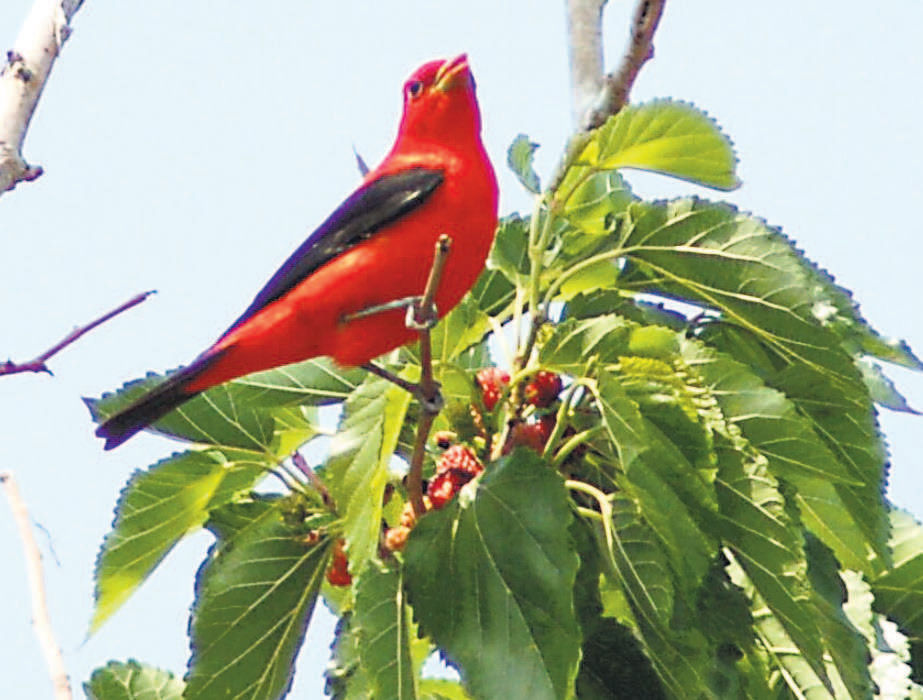Commercial fishermen need our support
April 20, 2016
Yum Yum! Chabert ER doctor locates his groove at helm of medical rockers
April 20, 2016No doubt, spring has finally sprung in Terrebonne Parish. For me and others like me, that means one very important thing: the spring migration of Neotropical songbirds. (Neotropical means they spend the summer in North America and the winter in Mexico, Central, and South America.)
When you read those words-bird watching-what images do they conjure up in your mind? Perhaps an image of an old man, wearing a straw hat, long Bermuda shorts with a field guide stuffed into the back pocket and binoculars hanging around his neck? Of course they did!
I’ve got news for you-in this millennium, bird watchers come from all walks of life and all age groups and from up and down the socioeconomic ladder. Banish the idea that bird watching is a sport for just the retired, who in their younger years would have been considered “nerds”. Being called a bird nerd nowadays is a feather in one’s cap, considering the mystique surrounding a successful bird watching trip.
By mystique, I mean the seemingly magical ability to sight tiny birds that only pass through here in the spring and fall. To watch for them without proper preparation would be akin to fishing in the spring and the fall without knowing ahead of time exactly where to go to find your target specie or what bait to use. Your trip wouldn’t be very successful, and it’s the same with bird watching. There’s much more to birding than stumbling around in the woods, blindly hoping to catch a glimpse of a painted bunting or rose-breasted grosbeak.
Even though bird watching can be challenging, the lucky beginner might wander out into the woods and see a flash of bright color here or there and not even realize he’s seeing a very rare Neotropical songbird. In contrast, the smart birder studies a reliable field guide, learning what the birds look like at all stages of life and phases of plumage and what markings to look for under the wings and on their bellies as the birds fly. The successful bird nerd knows whether the target birds eat seeds, berries, or insects and what kind of trees and plants bear their preferred diets. In short, good birders learn the habitat for a particular bird species to increase their chances of finding that bird as it passes through.
During the month of April, bird watchers from across the country, and maybe even some from around the world, will end up on Grand Isle in hopes of experiencing the “fallout”. A fallout occurs when the migratory birds finally see land after their long journey over the Gulf of Mexico. Ideally, the birds leave South America and Mexico ahead of a front, which pushes them along to North America where they will spend the spring and summer, returning south in the fall. Since there are no “bird rest stops” in the Gulf, the long trip exhausts the birds, causing them to literally fall out of the sky. Historically, that first land the migrants encountered off the coast of Louisiana was Isle Dernier, or Last Island, a 21-mile long island chain. This island chain has eroded significantly over the years, thereby increasing the migration distance, with fewer and fewer birds completing the trip every year. This challenge has resulted in a decline in both the number of
different migrant species and in the overall numbers of migratory birds that come through here every year.
As the islands and the habitat disappear, residents on Grand Isle compensate for these shortfalls by conserving and enhancing native habitat and by providing food and water for the visitors in their backyards. Grand isle resident Mr. Robert Santini, now deceased, was one of the first folks in Grand Isle to provide for the birds and later opened his yard to the public as part of the annual Grand Isle Bird Festival, which is April 15, 16, and 17 this year. I met Mr. Santini for the first time in 2004 when we talked at length about how he attracted so many beautiful birds to his yard. After I told him that I lived in lower Terrebonne Parish, he said that I could attract the very same birds to my yard, too. I took his advice, and just a year later, I learned that it was very good advice. Since that time, migratory songbirds like painted buntings, indigo buntings, blue and red-breasted grosbeaks, and many warbler species have stopped in my yard to rest, eat, and drink before heading north.
If you want to try your luck at bird watching but have no idea where to begin your birding studies, the best way to shortcut from beginner to bird nerd is to find the experienced birders in your area. In our area, the Terrebonne Bird Club is a great place to start. They’re easy to find on Facebook, just one way these millennial bird watchers are changing the old stereotypes! A couple years ago, bird club members trekked down to Grand Isle in hopes of catching a fallout. As they sat on the screened porch, birds started flying by, some hitting the screen and falling to the ground. Somehow, one bird flew into the interior of the camp and fell to the floor. Club member, Darlene Eschete, held the bird, a Redstart, to her chest to warm and revive it. She then walked across the highway into the woods and released the bird, which flew into the trees. “If you’re lucky, you will see a red mulberry tree full of scarlet tanagers. It looks like a Christmas tree, and that is the creme de la creme for birders!” explained Kathy Rhodes, VP of Terrebonne Bird Club.
Kathy Rhodes provided another example of how the millennial bird watchers have changed the face of birding. When I asked about her favorite birding field guide and binoculars, she said, “Many of our club members like the ‘Sibley Field Guide to Birds of Eastern North America’, but I use the free iPhone app called ‘Merlin Bird ID’ from Cornell. You’ll have to check with someone else about binoculars, because I tend to bird with my digital camera.” What did I tell you about that old stereotype?
Another trick used by modern-day birders is the bird-call app. Often birder watchers hear a bird but don’t ever see the actual bird. By listening to a birdcall app in their spare time or while driving, for example, they are able to learn the birds’ calls, making it easier to identify a bird only heard and not seen.
One thing that hasn’t really changed about birders is the Life List. Serious birders may travel the world in search of that one rare bird, and along the way, they keep a record of every bird they see, and when and where they saw it. In order to make it on the list, some folks say that at least one other person must see (or hear) the bird with you and both must make a positive ID.
By using their smart phones and digital cameras, millennial birders have fast-tracked and streamlined the identifying and recording process. By using the zoom lens on their digital cameras to get a close-up view for positive ID, they eliminate the need for binoculars. By referring to a bird ID app on their smart phones, they do away with the cumbersome filed guide. Lastly, by recording the bird list in their smart phone, they eliminate the bulky notebook they once carried for that purpose.
So, spring has sprung, and if you’ve ever wondered what all the fuss was about when it comes to traipsing through the trees looking for birds, there is no better time than the month of April to find out. Grab your camera and your smart phone, or maybe even an old-fashioned field guide, and head out to one of the many birding trails right here in Terrebonne Parish. Or if you feel like a road trip, head down to the Grand Isle Bird Festival. You won’t regret it, I promise!
Wendy Wilson Billiot is a freelance writer, wetland educator, and owner of Wetland Tours. She can be reached at bayouwoman.com
‘The successful bird nerd knows whether the target birds eat seeds, berries or insects and what kinds of trees and plants bear their preferred diets.’
Capt. Wendy Billiot
Cajun Sportsman Writer
A lovely, colorful bird looks down upon Louisiana’s marshlands after flying into a native tree. With springtime finally here, it’s the ideal time for bird watching – a hobby of many outdoors lovers.
The months of April and early May are prime times for bird watching, as migratory birds come into our area. On Grand Isle, countless species fill the island with color during the spring.









